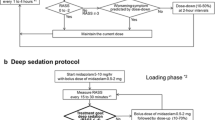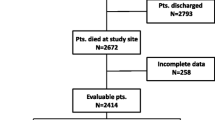Abstract
Purpose
This study investigated the effect of two types of palliative sedation defined using intervention protocols: proportional and deep sedation.
Methods
We retrospectively analyzed prospectively recorded data of consecutive cancer patients who received the continuous infusion of midazolam in a palliative care unit. Attending physicians chose the sedation protocol based on each patient’s wish, symptom severity, prognosis, and refractoriness of suffering. The primary endpoint was a treatment goal achievement at 4 h: in proportional sedation, the achievement of symptom relief (Support Team Assessment Schedule (STAS) ≤ 1) and absence of agitation (modified Richmond Agitation-Sedation Scale (RASS) ≤ 0) and in deep sedation, the achievement of deep sedation (RASS ≤ − 4). Secondary endpoints included mean scores of STAS and RASS, deep sedation as a result, and adverse events.
Results
Among 398 patients who died during the period, 32 received proportional and 18 received deep sedation. The treatment goal achievement rate was 68.8% (22/32, 95% confidence interval 52.7–84.9) in the proportional sedation group vs. 83.3% (15/18, 66.1–100) in the deep sedation group. STAS decreased from 3.8 to 0.8 with proportional sedation at 4 h vs. 3.7 to 0.3 with deep sedation; RASS decreased from + 1.2 to − 1.7 vs. + 1.4 to − 3.7, respectively. Deep sedation was needed as a result in 31.3% (10/32) of the proportional sedation group. No fatal events that were considered as probably or definitely related to the intervention occurred.
Conclusion
The two types of intervention protocol well reflected the treatment intention and expected outcomes. Further, large-scale cohort studies are promising.


Similar content being viewed by others
References
Seow H, Barbera L, Sutradhar R, Howell D, Dudgeon D, Atzema C, Liu Y, Husain A, Sussman J, Earle C (2011) Trajectory of performance status and symptom scores for patients with cancer during the last six months of life. J Clin Oncol 29(9):1151–1158. https://doi.org/10.1200/JCO.2010.30.7173
Hui D, Santos RD, Chisholm GB, Bruera E (2015) Symptom expression in the last seven days of life among cancer patients admitted to acute palliative care units. J Pain Symptom Manag 50(4):488–494. https://doi.org/10.1016/j.jpainsymman.2014.09.003
Beller EM, van Driel ML, McGregor L, Truong S, Mitchell G (2015) Palliative pharmacological sedation for terminally ill adults. Cochrane Database Syst Rev 1:CD010206
Cherny NI, ESMO Guidelines Working Group (2014) ESMO Clinical Practice Guidelines for the management of refractory symptoms at the end of life and the use of palliative sedation. Ann Oncol 25 Suppl 3:iii143–iii152
Cherny NI, Radbruch L, Board of the European Association for Palliative Care (2009) European Association for Palliative Care (EAPC) recommended framework for the use of sedation in palliative care. Palliat Med 23:581–593
Kirk TW, Mahon MM, Palliative Sedation Task Force of the National Hospice and Palliative Care Organization Ethics Committee (2010) National Hospice and Palliative Care Organization (NHPCO) position statement and commentary on the use of palliative sedation in imminently dying terminally ill patients. J Pain Symptom Manag 39:914–923
Verkerk M, van Wijlick E, Legemaate J, de Graeff A (2007) A national guideline for palliative sedation in the Netherlands. J Pain Symptom Manag 34(6):666–670. https://doi.org/10.1016/j.jpainsymman.2007.01.005
Morita T, Bito S, Kurihara Y, Uchitomi Y (2005) Development of a clinical guideline for palliative sedation therapy using the Delphi method. J Palliat Med 8(4):716–729. https://doi.org/10.1089/jpm.2005.8.716
Dean MM, Cellarius V, Henry B, Oneschuk D, Librach SL, Canadian Society Of Palliative Care Physicians Taskforce (2012) Framework for continuous palliative sedation therapy in Canada. J Palliat Med 15:870–879
Quill TE (1993) The ambiguity of clinical intentions. N Engl J Med 329:1039e1040
Jansen LA (2010) Disambiguating clinical intentions: the ethics of palliative sedation. J Med Philos 35:19e31
Claessens P, Menten J, Schotsmans P, Broeckaert B (2008) Palliative sedation: a review of the research literature. J Pain Symptom Manag 36(3):310–333. https://doi.org/10.1016/j.jpainsymman.2007.10.004
Papavasiliou ES, Brearley SG, Seymour JE, Brown J, Payne SA, EURO IMPACT (2013) From sedation to continuous sedation until death: how has the conceptual basis of sedation in end-of-life care changed over time? J Pain Symptom Manag 46(5):691–706. https://doi.org/10.1016/j.jpainsymman.2012.11.008
Morita T, Imai K, Yokomichi N, Mori M, Kizawa Y, Tsuneto S (2017) Continuous deep sedation: a proposal for performing more rigorous empirical research. J Pain Symptom Manag 53(1):146–152. https://doi.org/10.1016/j.jpainsymman.2016.08.012
Quill TE, Lo B, Brock DW, Meisel A (2009) Last-resort options for palliative sedation. Ann Intern Med 151(6):421–424. https://doi.org/10.7326/0003-4819-151-6-200909150-00007
Swart SJ, van der Heide A, van Zuylen L, Perez RS, Zuurmond WW, van der Maas PJ, van Delden JJ, Rietjens JA (2012) Considerations of physicians about the depth of palliative sedation at the end of life. CMAJ 184(7):E360–E366. https://doi.org/10.1503/cmaj.110847
Seymour J, Rietjens J, Bruinsma S, Deliens L, Sterckx S, Mortier F, Brown J, Mathers N, van der Heide A, UNBIASED consortium (2015) Using continuous sedation until death for cancer patients: a qualitative interview study of physicians’ and nurses’ practice in three European countries. Palliat Med 29(1):48–59. https://doi.org/10.1177/0269216314543319
Schildmann EK, Schildmann J, Kiesewetter I (2015) Medication and monitoring in palliative sedation therapy: a systematic review and quality assessment of published guidelines. J Pain Symptom Manag 49(4):734–746. https://doi.org/10.1016/j.jpainsymman.2014.08.013
de Graeff A, Dean M (2007) Palliative sedation therapy in the last weeks of life: a literature review and recommendations for standards. Palliat Med 10(1):67–85. https://doi.org/10.1089/jpm.2006.0139
Jacobi J, Fraser GL, Coursin DB, Riker RR, Fontaine D, Wittbrodt ET, Chalfin DB, Masica MF, Bjerke HS, Coplin WM, Crippen DW, Fuchs BD, Kelleher RM, Marik PE, Nasraway SA Jr, Murray MJ, Peruzzi WT, Lumb PD, Task Force of the American College of Critical Care Medicine (ACCM) of the Society of Critical Care Medicine (SCCM), American Society of Health-System Pharmacists (ASHP), American College of Chest Physicians (2002) Clinical practice guidelines for the sustained use of sedatives and analgesics in the critically ill adult. Crit Care Med 30(1):119–141. https://doi.org/10.1097/00003246-200201000-00020
Zomorodi K, Donner A, Somma J, Barr J, Sladen R, Ramsay J, Geller E, Shafer SL (1998) Population pharmacokinetics of midazolam administered by target controlled infusion for sedation following coronary artery bypass grafting. Anesthesiology 89(6):1418–1429. https://doi.org/10.1097/00000542-199812000-00020
Somma J, Donner A, Zomorodi K, Sladen R, Ramsay J, Geller E, Shafer SL (1998) Population pharmacodynamics of midazolam administered by target controlled infusion in SICU patients after CABG surgery. Anesthesiology 89(6):1430–1443. https://doi.org/10.1097/00000542-199812000-00021
Albrecht S, Ihmsen H, Hering W, Geisslinger G, Dingemanse J, Schwilden H, Schüttler J (1999) The effect of age on the pharmacokinetics and pharmacodynamics of midazolam. Clin Pharmacol Ther 65(6):630–639. https://doi.org/10.1016/S0009-9236(99)90084-X
Bremer F, Reulbach U, Schwilden H, Schüttler J (2004) Midazolam therapeutic drug monitoring in intensive care sedation: a 5-year survey. Ther Drug Monit 26(6):643–649. https://doi.org/10.1097/00007691-200412000-00010
Pecking M, Montestruc F, Marquet P, Wodey E, Homery MC, Dostert P (2002) Absolute bioavailability of midazolam after subcutaneous administration to healthy volunteers. Br J Clin Pharmacol 54(4):357–362. https://doi.org/10.1046/j.1365-2125.2002.01665.x
Carson MG, Fitch MI, Vachon ML (2000) Measuring patient outcomes in palliative care: a reliability and validity study of the Support Team Assessment Schedule. Palliat Med 14(1):25–36. https://doi.org/10.1191/026921600677786382
Miyashita M, Matoba K, Sasahara T, Kizawa Y, Maruguchi M, Abe M, Kawa M, Shima Y (2004) Reliability and validity of the Japanese version of the Support Team Assessment Schedule (STAS-J). Palliat Support Care 2(4):379–385
Lichtner V, Dowding D, Esterhuizen P, Closs SJ, Long AF, Corbett A, Briggs M (2014) Pain assessment for people with dementia: a systematic review of systematic of pain assessment tools. BMC Geriatr 14:138
Sessler CN, Gosnell MS, Grap MJ, Brophy GM, O’Neal PV, Keane KA, Tesoro EP, Elswick RK (2002) The Richmond Agitation-Sedation Scale: validity and reliability in adult intensive care unit patients. Am J Respir Crit Care Med 166(10):1338–1344. https://doi.org/10.1164/rccm.2107138
Benítez-Rosario MA, Castillo-Padrós M, Garrido-Bernet B, González-Guillermo T, Martínez-Castillo LP, González A, Members of the Asocación Canaria de Cuidados Paliativos (CANPAL) Research Network (2013) Appropriateness and reliability testing of the modified Richmond Agitation-Sedation Scale in Spanish patients with advanced cancer. J Pain Symptom Manag 45:1112–1119
Imai K, Morita T, Mori M, Yokomichi N, Fukuta K (2016) Development and linguistic validation of the Japanese version of the modified Richmond Agitation-Sedation Scale. Palliat Care Res 11(4):331–336 (in Japanese). https://doi.org/10.2512/jspm.11.331
Oken M, Creech R, Tormey D, Horton J, Davis TE, McFadden ET, Carbone PP (1982) Toxicity and response criteria of the Eastern Cooperative Oncology Group. Am J Clin Oncol 5(6):649–655. https://doi.org/10.1097/00000421-198212000-00014
Elsayem A, Curry Iii E, Boohene J, Munsell MF, Calderon B, Hung F, Bruera E (2009) Use of palliative sedation for intractable symptoms in the palliative care unit of a comprehensive cancer center. Support Care Cancer 17(1):53–59. https://doi.org/10.1007/s00520-008-0459-4
Sykes N, Thorns A (2003) The use of opioids and sedatives at the end of life. Lancet Oncol 4(5):312–318. https://doi.org/10.1016/S1470-2045(03)01079-9
Acknowledgements
This study was conducted with the cooperation of the palliative care unit of the Seirei Mikatahara General Hospital. The authors would like to thank all the participants. This study was supported by the Japanese Society for the Promotion of Science KAKENHI Grant Number JP16H05212.
Author information
Authors and Affiliations
Corresponding author
Ethics declarations
Conflict of interest
The authors declare that they have no conflict of interest.
Rights and permissions
About this article
Cite this article
Imai, K., Morita, T., Yokomichi, N. et al. Efficacy of two types of palliative sedation therapy defined using intervention protocols: proportional vs. deep sedation. Support Care Cancer 26, 1763–1771 (2018). https://doi.org/10.1007/s00520-017-4011-2
Received:
Accepted:
Published:
Issue Date:
DOI: https://doi.org/10.1007/s00520-017-4011-2




